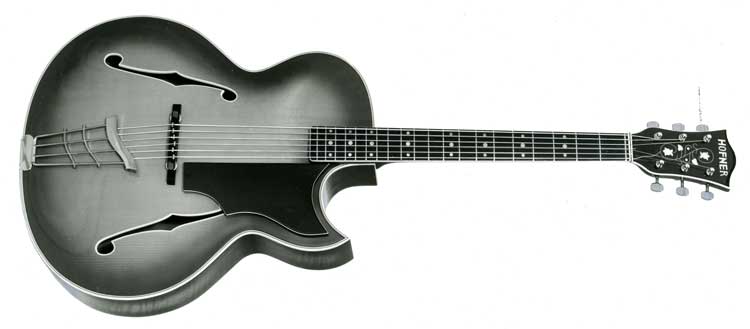
We have seen in an earlier chapter that whilst
the first batch of Hӧfner thinline/semi-acoustic guitar models were being born
in the 1960’s, at around the same time the Hӧfner Company reduced substantially
the number of full-bodied archtop models that had been developed during the
1950’s. This did not mean however that Hӧfner intended abandoning archtop
development. In 1969, Hӧfner un-veiled two new models, which were probably
intended to eventually replace some of their remaining “traditional” archtops.
These models were the Höfner 477 and the Hӧfner 471.
The 477 was a mid-range “working man’s” archtop,
very much in the mould of the Hӧfner 457 and President models. It did however
have a larger body than those two models with a 17” lower bout measurement and a
slightly deeper body depth of 3¼” (80mm). Most noticeable was the Florentine
body cutaway and the very slender and graceful F-shaped soundholes. A more
fundamental design aspect however was the one-piece maple neck with an unusually
small heel. A laminated spruce top and laminated flame maple back & sides made
up the body. The Hӧfner bell-flower mother of pearl inlay on the headstock and
triple-dot fret markers suggested a close affinity with the President model. The
477 was available in fully acoustic format or fitted with twin pickups, and a
thinline electric version, designated as the 4577 (ii) also appeared at the same
time in 1969.
The 477 appears to have been a good seller, as
there are still plenty of examples about. Another indication of this popularity
is that the model was kept in Hӧfner’s catalogue right up to 1995.
The other guitar introduced with the 477 in 1969
did not have the same sales figures. The Hӧfner 471 was probably intended to be
a future replacement for the Hӧfner 470. Its basic design was that of the 477,
i.e. a large 17” body with slender F-holes, Florentine cutaway, and a one-piece
maple neck with small heel. Its body depth however was even greater than the
477, being 3½” (90mm). The basic components of body and neck used in its
construction were probably drawn from the 477 stock. Decoration on the guitar
was impressive however, with the first appearance of a new “double fleur-de-lys”
Hӧfner design, inlaid with mother of pearl, on the headstock, and split-block
fret markers. Plenty of pearloid binding and multi-purfling was provided around
the body, neck and soundholes, and all fittings including the beautifully
engraved escutcheon tailpiece were gold plated. It really did look the business,
but without the fussiness of the 470. This was intended to be a modern archtop
guitar which would cater for a more sophisticated clientele perhaps than the
more blatantly luxurious 470.
Just as with the 477, a thinline electric version
with 50mm deep body was also offered with the designation of Model 4710.
Unfortunately, this guitar does not seem to have
sold so well, perhaps understandably as in 1969 its list price was DM 1075 for
the electric version, as compared to DM 421 for a 477/E2 and DM 860 for Hӧfner’s
previous most expensive archtop, the 470/E2 model. However, the full-bodied
guitar remained in the Hӧfner price lists until 1977 and the thinline until
1978.
Setting a single pickup on the end of the
fingerboard so that it “floats” above the guitar’s top or “table” seems like the
obvious thing to do if one wishes to avoid effecting the resonance of the table
by screwing the pickup directly onto it, and of course this is considered to be
the correct thing to do these days when producing Jazz guitars. However, that
was not always the case. Gibson’s archtops had led the way in electrifying
archtops with pickups mounted directly onto the body top, and this practice was
also adopted by other manufacturers including Hӧfner. “Floating” pickups had
been available as accessories since the mid 1950’s, with in particular DeArmond
supplying these in the US and the likes of Fuma/Hӧfner in Germany. The main
emphasis back then however seems to have been for a simple and cheap method of
amplifying the customer’s previously purchased acoustic instrument, rather than
for the acoustic advantages gained in keeping the pickup unit off the table.
The first signs that Hӧfner were waking up to the
advantages of floating pickups came in their introduction of such a factory
equipped guitar in 1977. This model was designated the Hӧfner 478 E. It reverted
back to being a Venetian cutaway large bodied guitar, with a conventional size
neck heel. In fact, it would seem that Hӧfner were consciously doing everything
to make this guitar as traditional and straight-forward as possible – the
classic Jazz guitar.
A fully acoustic version was also offered. Simple
white binding was used throughout with block fret markers, and the comparatively
simple double-diamond headstock inlay was one of Hӧfner’s smaller versions. The
bridge was a traditional carved rosewood type, and the guitar was finished in a
conservative brown-red-yellow sunburst. The only extravagance was the use of an
escutcheon tailpiece, but that was only nickel plated and without any engraving.
However, the guitar only lasted for a year in the Hӧfner price list and does not appeared to have sold very well at all. Perhaps, it was too anonymous to attract the buyers? What we do know however is that Hӧfner withdrew it at the end of 1977, together with the 471, in order to make way for their new archtop flagship – the A2L model.
As a postscript though, a very small number of 478 bodies and necks seem to have been left over however, and these were eventually fitted with conventional twin pickup electrics fitted directly onto the body tops and then sold off as 4550/E2 model guitars in the late 1980s.
__________________________________________________
All Text is Copyright
© 2022 Steve Russell. All Rights Reserved